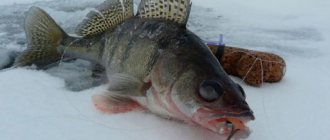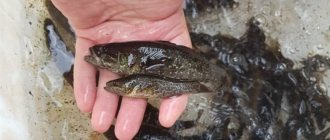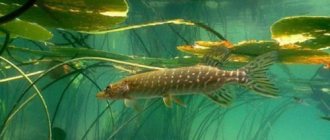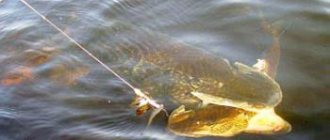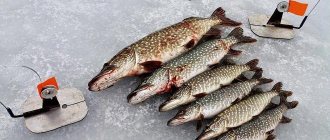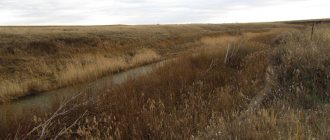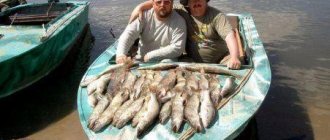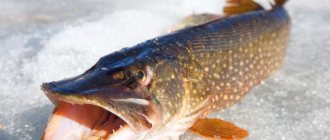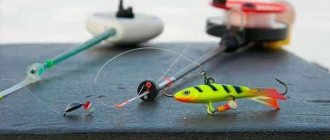When to catch pike with a balance beam
It is believed that pike is always active on the first ice. However, there are times when a toothy predator refuses to take the bait and there is no way to force it. And the capricious weather is to blame. When going fishing you should consider the following points:
- fluctuations in atmospheric pressure negatively affect the activity of pike;
- if the winter is warm, then throughout the winter high activity of the toothed predator is possible;
- cloudy weather is better suited for winter pike fishing on a balance beam;
- light snowfall, no frost, slight south or southwest wind;
- on clear frosty days, pike is just as active, but much less;
- It’s better to go fishing while it’s still dark, so you can start fishing at dawn.
Read also about fishing on the first ice at:
- Perch
- Roach
Pike activity in February
Pike behave differently in different regions in February. In the North, this whole month is a harsh time, you need to focus on a passive predator, and catch according to the rules of pike in the wilderness. In the middle zone sometimes (if there is a warm winter and early spring), and in the south always, already from the middle of the month the February pike becomes more active. At this time, frequent thaws force the predator to leave its habitat and go out into shallow waters in search of food. The pike bite in February is unstable and depends on many factors:
- Time (beginning of the month or end), depending on the region.
- Migrations of forage fish.
- Oxygen saturation of water.
- Moon phases and weather.
- Internal specific feeding rhythms in this particular body of water.
There may be many reasons why pike do not bite in February. No catch today - tomorrow it could be different. Favorable days for pike fishing in February are determined only theoretically - these are thaws and periods of smooth weather without sudden changes. In practice, you can get to the exit of a predator even in terrible bad weather, blizzards and frost. In some reservoirs, the toothy fish is inactive, in others, pre-spawning migrations and even feeding begin at the end of the month.
Tackle for catching pike on a balance beam
Fishing for pike in winter on a balance beam should be carried out with high-quality tackle:
- As a fishing rod, you can take a shortened version of a spinning rod, or use an original plastic fishing rod. It will be convenient to use a handle made of non-thermal conductive material. The length of the whip can be from 20 to 40 cm. The longer this element of the tackle, the easier it will be to absorb pike blows.
- Most fishing rods are already equipped with an inertial reel. Otherwise, you can use a baitcasting reel. There are special models of multipliers for winter fishing. Such reels are equipped with a friction brake, which makes it much easier to catch a predator.
- Whether to use fishing line or braid is a controversial issue. The fishing line does not freeze as much as braid, so most anglers use it. It is advisable to use fluorocarbon fishing line - it is more resistant to abrasion on the edge of the ice. The optimal diameter of the fishing line will be 0.25-0.3 mm. Braided wire is a stronger option, the reliability of which is beyond doubt. You just can’t use it in cold weather. When fishing regularly, it is necessary to cut off the used piece, as its strength is lost due to friction against the edges of the hole.
- A leash is mandatory when fishing for pike. It is convenient to use leads from a guitar string numbered 1 or 2. This element of the equipment should not be deformed or bent, otherwise the play of the balancer will be disrupted.
End of February
The increase in day length, average daily temperatures and light levels at the beginning and end of the month vary significantly. It's heading towards spring. Therefore, in most reservoirs, although outwardly the weather does not yet smell like spring, the predator becomes active along with the rest of the fish. Developing eggs and milt require the supply of nutrients consumed over the winter. The pike, following the small fish, leaves the depths and begins to feed intensively. The winter Eldorado is coming for spinners and giraffes, which will gain maximum strength in March.
The behavior of pike in large reservoirs in February is different - it begins to wake up earlier. This is due to the fact that in large reservoirs, pike migrate in the spring to spawn in tributaries, covering long distances. And now, even though the reservoir is still covered with a meter-long layer of ice, she is beginning to prepare for this journey. Usually pike do not come in a continuous mass. At first, only a few individuals leave the pits for a short time. But every day these phenomena are intensifying. With the beginning of the melting of snow and ice, almost all the pike will already be in shallow waters in the coastal strip, near river mouths. On small rivers and closed ponds (lakes), you need to look for resident pike in the same place as always. Large reservoirs are distinguished by their specifics.
Where to look for pike at the end of February? More often these are coastal waters with shallow depths of up to 3 meters (usually 1-2 m) with thickets of last year’s dry reeds, reeds and cattails, estuary bays, areas near dams, dams, locks and other hydraulic structures. Depending on the region, travel times vary greatly. The fisherman needs to make inquiries specifically about his own body of water. Therefore, studying pike biting calendars in February or tables is useless. It is better to thoroughly study the features of the reservoir, check the information with local fishermen or on forums. On large bodies of water, you need to strategically determine in which area of the water area the pike is now. And this information will not be relevant for long - soon the predator will move on. However, some of the stock does not go far, spawning not far from their places, in the coastal strip. Therefore, you can always find a random resident individual, even if the main body of fish has disappeared.
How to choose a balancer for pike
Today's market presents the modern fisherman with a wide range of balancers. What you need to consider when selecting balancers for pike, read below:
- The size of the balancer should be in the range from 5 to 10 cm. Lures from 5 to 7 cm in size can be considered universal - they also catch perch well. The most preferred size for pike is 7 to 9 cm.
- Tees on pike balancers must be numbered from 4 to 6 according to the international classification. The tee can be supplemented with a drop of weight so that when casting it does not overlap the fishing line.
- Popular pike colors include perch imitation, white with red head, and a variety of fancy colors.
- The shape of the balancer does not have a significant size, but it is believed that the wider belly of the bait contributes to excellent gliding properties.
- The balancer hooks should be large enough with a large offset - the tip of the hook should not extend into the bait area.
Read also: The best balancers for pike
Fishing methods
Let's look at how and what to catch pike in February. Fishing tactics, technique and equipment of gear are determined by the level of activity of the toothy fish. Winter fishing for pike in February can be very different, depending on whether it has a deep-winter hunting mode, or whether the toothy one has already woken up and started actively feeding. For a passive predator, you need the same gear and fishing methods that were used in the dead of winter - this is more delicate equipment, small baits and thin transparent leashes. The lure fishing technique needs to be sluggish and slow - for passive pike. For active fish, the usual rough tackle with metal leashes, the usual game and the whole range of baits for vertical trolling are used.
Zherlitsy
February fishing for predators using baits of various kinds is more common. Despite the increased activity, in most reservoirs the toothy fish prefers small baitfish (the cavity of the internal organs is occupied by eggs and swallowing large prey is problematic). And this is also a factor of increasing activity, because small fish need to be swallowed more in order to cover the need for nutrients. Catching pike with live bait in February is interesting and productive - the main thing is to find an active predator. About where to catch pike in February, what equipment to use on the girders - in a separate article:
https://podlednik.ru/lovlya_zimoj/zherlicy/shhuka-v-fevrale-flazhki
Spoons
We try to seduce passive fish, as in the middle of winter, with small spoons, using slow play and thin equipment. An active predator will attack a wider range of baits. The severity of the wilderness no longer weighs us down - we use the tactics, techniques and gear of classic winter fishing. Catching pike in February with lures is a popular travel fishing activity. For active fish, the more kilometers you walk and check promising places, the richer the catch. It is better to use small baits. You need to use and check different ones - you never know what will attract the toothy fish in this particular body of water. An article about winter lures for pike.
Crab spoon with bait
Ratlins
Rattlins (bladeless wobblers) are becoming more and more popular among winter roads, settling in the bait bags of an increasing number of spinners. For February pike, these baits are also worth using. Sometimes these decoys work when the spinners are silent. This type of bait requires the angler to master the playing technique. Each ratlin requires an approach, an individual game. Read more about winter pike fishing with ratlins.
Balancers
Of course, good old balancers also work. Catching pike in February with a balance beam also depends on the level of activity of the predator. At the beginning of the month it is better to use small baits, maybe even bladeless ones with a tassel or twister on the back hook. For active pike we use the entire range of baits and standard game. The technique of play and the choice of bait color depend on the conditions of the reservoir and the preferences of the predator. These features are revealed already on the ice during fishing. Read more about winter fishing for pike with balance beams.
Ice jig
Fishing with silicone or edible rubber from ice is becoming increasingly popular. The gear is used as for trolling - a durable flexible fishing rod, a reel, a leash of at least 20 centimeters. Game - tapping on the bottom or various options for vertical play. The weight of the sinker is selected depending on the conditions. An absolute advantage is the ability to fish in strong currents (using a heavy jig head) vertically or by pulling under the ice. This is useful if you manage to find active fish, for example, at the entrance to tributaries or going upstream on small rivers.
What is a balancer
A balancer is a type of spoon that resembles a fish in appearance. It is attached to the fishing line in the back area, which ensures its horizontal position in relation to the bottom. In other words, it seems to balance on the main line, which is why it got its name.
Using a balancer you can catch predatory fish such as pike, perch, pike perch, etc. There are various designs of such bait, differing in size, color and mounting methods. As for pike, larger models should be chosen for fishing, especially at the beginning of winter. In the midst of real cold weather, when pike loses its activity, smaller specimens of balancers should be used to catch it. During periods of short-term warming, you should again pay attention to larger baits, as the pike begins to become more active.
You can buy a balancer in a store, purchase it at the market, or make it yourself. Most winter fishing enthusiasts prefer to go the DIY route. Firstly, it is interesting, and secondly, it saves money.
Which balancer to use on pike
When going fishing, you should stock up on several balancers, which could differ in color and size. Depending on weather conditions, you will have to experimentally determine which balancer the pike prefers. If you have several different baits in your arsenal, then choosing the right bait will not be difficult.
Balancer size
Weather conditions have a serious impact on the behavior of pike, and the biting activity depends on its behavior. As a rule, larger baits catch larger fish, although the intensity of bites is somewhat reduced.
They begin to catch pike on balance beams, about 4 cm long. At the same time, you need to take into account that the number of bites will be higher, and the catch may include small pike and medium-sized perch, which may be more numerous than pike.
If the bite is active, then you can switch to a balancer, about 7 cm long. In this case, there will be fewer bites, and if a perch bites, it will probably not be small. Pike weighing 1 kg or more can begin to bite on such a balancer, although the number of bites will drop sharply. If the fish continues to actively bite, then it makes sense to switch to a balancer, about 9 cm long. Naturally, the bite will decrease, but there is every chance of catching a trophy pike. Although it is quite possible that there will be no bites at all on a 9-centimeter balancer.
Which balancer to fish with is the choice of every angler. One angler is interested in the number of bites, so as not to get bored near the hole, and the second is interested in the size of the fish caught, although you can meet fishermen who like both. Some winter fishing enthusiasts are ready to sit idle over a hole all day just to catch a trophy pike.
As a rule, there are baits of larger sizes. You can catch pike with such balancers, but the fishing technique needs to be honed on small models and only then move on to heavier models
Basically, fishermen act according to the following algorithm: if the pike has stopped biting on a balance beam 9 cm long, then you need to return to the previous size of 7 cm. Very often, when changing the bait to a smaller one, the biting activity increases. If the pike does not want to take such a bait, then you need to take a balancer up to 5 cm long and catch the fish that prefers such a balancer, otherwise you may be left without a catch at all.
It should be remembered that in the depths of winter large baits are not popular and can be forgotten about. But closer to spring, when the pike begins to become active again, you can try using larger models.
Balancer color
It is believed that the color of the balancer does not particularly affect the bite activity, but the color should not be neglected, since other fishermen believe that color sometimes plays a decisive role. Balancer colors can be divided into three separate categories:
- Natural.
- Dark.
- Acidic.
Most anglers prefer natural colors of baits. In other words, baits of such colors perfectly imitate the coloring of a living fry, some type of fish.
It is preferable to use dark colors in bright sun conditions, when the glare from shiny baits can scare away predators. Too bright baits alert the predator in clear water conditions.
Acid colors are more effective at great depths or in turbid water. But this does not mean at all that such baits will not be effective in other fishing conditions.
As a rule, the color of a particular pike bait is selected as a result of trial and error, since every fishing trip carries with it a certain element of unpredictability. Depending on different weather conditions, the color of the bait that the pike will like is difficult to predict. Therefore, you need to take several different types of balancers with you. As a rule, experienced fishermen have dozens of balancers, which differ from each other in both size and coloring. In addition, different hook attachments are possible, which can affect the effectiveness of the entire fishing trip.
When fishing holes, especially in conditions of weak bite, it makes sense to try several colors on each hole. This way you can quickly decide on pike preferences.
Soldering balancers
The second method of making balancers involves soldering baits from various non-ferrous metals. Most often, copper or brass are used as the latter, which are easy to process. The main difficulty of this method is to achieve not only a beautiful appearance of the bait, but also to make it really work.
Having decided on the size of the future bait, the blank is cut out of a thin sheet of non-ferrous metal. To bend it and give it the desired shape, you will need a vice, but it is important not to overdo it. Then miniature rings are soldered into the inner surface for attaching treble hooks.
Balancing is done by changing the amount of solder in the head or tail. Painting is not necessary, as you can leave the original color and shine of the metal. Imitation of scales is done using a punch. The eyes of a metal fish can also be carved out or painted with high-quality paint.
Casting balancers
For this method you will need plaster, stainless wire with a diameter of approximately 0.5-0.7 mm, lead, a pair of single hooks and a finished bait, which will be used as a sample.
First you need to prepare the mold itself for casting. Gypsum is diluted so that its density and viscosity resembles thick sour cream, then it is poured into a previously prepared container, greased with grease. Next, you need to remove the tee from the donor balancer and disconnect the tail, also smear its body with grease and drown it halfway in plaster.
When the plaster dries, its surface is sanded and leveled, then centering recesses are made. The sample balancer and the surface of the mold itself are re-lubricated with solid oil, and a second layer of gypsum is poured on top so that the bait is completely inside.
After waiting for the plaster to dry again, the form is leveled on the sides and disassembled into two parts. Next you need to make a small casting hole and an opening for free air outlet.
Before the casting process itself, the mold is warmed up. The prepared hooks and wire loops are placed in the grooves, one part of the plaster mold is connected to the other, after which you can proceed directly to casting.
At the final stage of manufacturing, the balancer is processed with a file, painted (for example, with oil paints) or varnished. The tail, which can be made from an ordinary plastic bottle, is glued using superglue, after which it is better to additionally secure it with epoxy resin.
